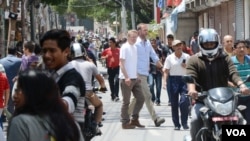Officials walked through the quake-damaged streets of Chautara Wednesday, ordering people to leave damaged buildings as the search continued for a missing U.S. helicopter, a day after a second major earthquake struck Nepal in less than three weeks.
Rescue work, which had been suspended after the April 25 quake, resumed once again. Troops and search teams are fanning out to look for survivors in the wreckage caused by Tuesday's 7.3-magnitude quake, which killed more than 70 people, injured nearly 2,000, and caused landslides that blocked roads, slowing the delivery of relief supplies.
It was a step back for the government and aid agencies, which had just started work on long-term recovery and rehabilitation planning.
Krishna Chandra Chalisey of the International Committee of Red Cross in Nepal told VOA the number of homeless in the country increased after Tuesday’s quake, which further damaged or destroyed many houses that had been affected by the April 25th quake.
Nearly 300,000 homes were destroyed in the earlier quake and many others were deemed too dangerous to live in.
The situation is especially bleak in Dolakha and Sindhupalchowk, two of the districts worst affected by the original quake, bore the brunt of the damage caused by the fresh tremors. In Dolakha, an estimated 90 percent of the houses have been flattened.
With the U.S. Geological Survey reporting about 20 aftershocks since Tuesday, thousands of people spent the night outdoors – just as they did following the April 25 earthquake that killed more than 8,000 people – with fears that aftershocks could bring down more buildings.
From relief to rescue operations
Laxmi Prasad Dhakal, spokesman for the Nepal home ministry, told Reuters, "We had been focusing on relief distribution, but from yesterday our resources were deployed for rescue operations again."
Chalisey, of the Red Cross, said the power supply and telecommunication networks in several affected districts are also not fully functional, making the humanitarian task more challenging.
Other aid workers pointed out that the devastation caused by Tuesday’s earthquake in Nepal may have been lesser than that wrought by last month's quake, but the psychological impact on people, particularly children, was even harder.
Sudarshan Shrestha, with Save the Children Nepal, works in Dolakha and Sindhupalchok districts. He told VOA Tuesday’s jolt was a “double trauma” as it struck just when people and children had started getting back on their feet.
Shrestha said when he visited young children in tented camps after the quake, many were in shock and could barely utter a word. He said it will be hard for them to overcome their fears.
Nepalese officials said schools, which are scheduled to open later this month, could remain shut closed for a while.
Missing helicopter
Also Wednesday, hundreds of Nepali troops searched for a missing U.S. Marine helicopter with eight people – six Marines and two Nepali soldiers – on board.
A spokesman for the U.S. Pacific Command said the helicopter, which was delivering aid in Dolakha, one of the districts hit hardest by both quakes, went missing late Tuesday near Charikot village.
Two helicopters were taking part in the search early Wednesday with other aircraft due to join the operation, the spokesman said.
A Defense Department official said there was no evidence yet that the helicopter has crashed. A nearby Indian helicopter heard radio chatter about a possible fuel problem, said U.S. Army Colonel Steve Warren.
The Nepalese government has acknowledged that it was overwhelmed by the scale of the April 25 disaster, which destroyed nearly 300,000 homes and left many more too dangerous to live in.
The impoverished country appealed for billions of dollars in foreign aid after the first quake, as well as medical experts to treat the wounded and helicopters to ferry food and temporary shelters to hundreds of thousands left homeless amid unseasonal rains.
On Wednesday, Jamie McGoldrick, a U.N. official in Nepal, said the U.N. has revised its appeal to international donors to provide $423 million as against $415 million sought earlier for relief work to last three months given the magnitude of the task.
He also said the response to the U.N. appeal has been poor and so far received only about 15 percent.
Among 14 quake-hit districts, some are very inaccessible. A large part of population could not be reached easily as roads have been damaged by the earthquake.
"Some [areas] are even difficult to reach by helicopter. We are facing monumental challenge here to support the government in these districts to have credible response,'' McGoldrick said.
Another potential disaster is also brewing in Nepal: The annual monsoon season is approaching and scientists worry that the torrential rains could trigger landslides and put more lives in peril.
Chain reaction
Scientists said Tuesday's quake was part of a chain reaction set off by the larger one that struck on April 25 in Lamjung district west of Kathmandu.
"Large earthquakes are often followed by other quakes, sometimes as large as the initial one," Carmen Solana, a volcanologist at Britain's University of Portsmouth, said in an AFP report.
"This is because the movement produced by the first quake adds extra stress on other faults and destabilizes them," Solana told the London-based Science Media Center.
Some material for this report came from Reuters, AFP and AP.










